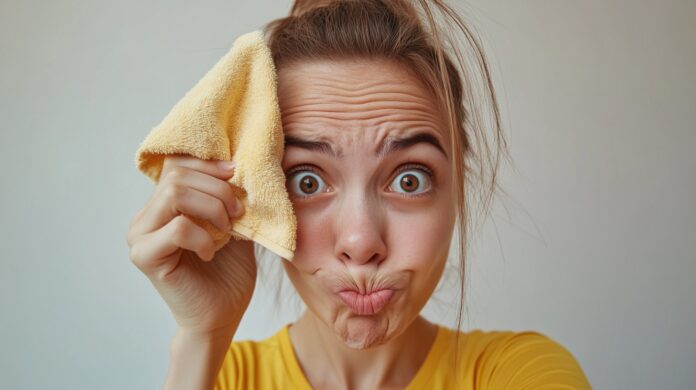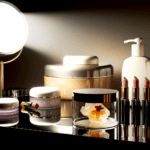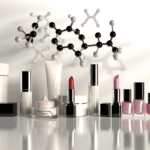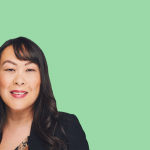Introduction to Titanium Dioxide
What is Titanium Dioxide?
Titanium dioxide (TiO2), also known as titania, is a naturally occurring mineral that is mined and processed to create a fine, white powder. It is the most widely used white pigment due to its brightness and very high refractive index, which surpasses that of diamond. In its pure form, titanium dioxide is a non-toxic, inert substance.
Common Uses in Cosmetics
Titanium dioxide is extensively used in the cosmetics industry for a variety of purposes. It is a key ingredient in sunscreen formulations, providing protection against ultraviolet (UV) radiation due to its strong UV light-absorbing capabilities. Additionally, it is used to impart whiteness and opacity to products such as foundations, powders, and toothpaste. Its presence in makeup helps to achieve a desired consistency and finish, enhancing the product’s aesthetic appeal.
Perceived Benefits in Cosmetic Products
- Sun Protection: Titanium dioxide is valued for its effectiveness as a physical sunscreen agent. It scatters and reflects UV rays away from the skin, thereby protecting it from sun damage.
- Color and Opacity: Due to its high refractive index, titanium dioxide adds opacity and coverage to cosmetics, allowing for better concealment of skin imperfections and a more even skin tone.
- Safety Profile: It is often preferred over chemical UV filters and colorants because it is considered to be less irritating and more suitable for sensitive skin.
Despite its widespread use and benefits, concerns have been raised about the safety of titanium dioxide in cosmetics, particularly when it is in nanoparticle form. These concerns stem from studies suggesting that nanoparticles may penetrate the skin or be inhaled, potentially leading to health risks. Regulatory agencies continue to evaluate the safety of titanium dioxide in cosmetic products, with some recommending the use of non-nano forms of the substance to mitigate potential risks.

Do you have the most commonly used but toxic, disease bringing chemicals in your skin care? Many chemicals in skincare are hormone disruptors and make menopause symptoms worse.
Find out more…
Safety Profile of Titanium Dioxide
Current Research on Titanium Dioxide Safety
Recent studies have focused on the safety profile of titanium dioxide (TiO2), particularly in its nanoparticle form. Research has shown that the physicochemical properties of TiO2 nanoparticles, such as size, shape, and surface characteristics, can influence their biological interactions and potential toxicity. While TiO2 is generally recognized as safe by the FDA when used in food, concerns have been raised about its safety as a nanoparticle due to its increased reactivity and potential for cellular uptake.
Studies have indicated that TiO2 nanoparticles can generate reactive oxygen species (ROS) when exposed to UV light, leading to oxidative stress in cells. This has raised questions about the use of TiO2 nanoparticles in sunscreens and other cosmetic products. Additionally, research has suggested that TiO2 nanoparticles may accumulate in various organs when ingested, although the absorption rate is generally low. The long-term effects of this accumulation are not yet fully understood, necessitating further research.
Regulatory Stance on Titanium Dioxide in Cosmetics
Regulatory agencies have taken different stances on the use of TiO2 in cosmetics. The FDA allows the use of TiO2 as a color additive in food, drugs, and cosmetics, including sunscreens, with specific concentration limits. However, the European Commission has banned the use of TiO2 nanoparticles in sprayable sunscreen products due to inhalation risks. The European Food Safety Authority (EFSA) has also expressed concerns about the use of TiO2 as a food additive (E171), leading to a ban in France.
Despite these regulatory measures, there is still a lack of consensus on the safety of TiO2 nanoparticles, and regulatory bodies continue to evaluate the latest scientific evidence. The need for standardized testing methods and clearer guidelines on the use of TiO2 nanoparticles in consumer products is evident.
Potential Health Risks
The potential health risks associated with TiO2 nanoparticles are a subject of ongoing research. Inhalation exposure, particularly in occupational settings, has been linked to respiratory issues and possible carcinogenic effects. The IARC has classified TiO2 as a Group 2B carcinogen, indicating that it may be possibly carcinogenic to humans when inhaled in high concentrations.
Oral exposure through ingestion of food products containing TiO2 nanoparticles has raised concerns about gastrointestinal absorption and the impact on gut microbiota. Studies have shown that TiO2 nanoparticles can affect the intestinal barrier and may exacerbate pre-existing inflammatory conditions.
Dermal exposure through the use of sunscreens and cosmetics containing TiO2 nanoparticles has also been scrutinized. While the skin’s stratum corneum acts as a barrier, there is evidence that nanoparticles may penetrate damaged or sunburnt skin, leading to systemic exposure.
In conclusion, while TiO2 is widely used in various industries, the safety of its nanoparticle form remains a topic of debate. Further research is needed to fully understand the health implications of TiO2 nanoparticles and to inform regulatory decisions that protect public health.

Popular Read: Endocrine Disruptors in Skincare: What You Need to Know
Titanium Dioxide and Endocrine Disruption
Understanding Endocrine Disruptors
Endocrine disruptors are chemicals that can interfere with the endocrine system—the network of glands and hormones that regulate the body’s normal functions. These disruptors can mimic, block, or alter hormones and, as a result, may cause a ripple effect of health issues. The endocrine system is crucial for many bodily processes, including growth, metabolism, and reproduction. Therefore, substances that disrupt its balance can have significant implications for overall health and wellness.
Evidence Linking Titanium Dioxide to Hormonal Imbalances
Recent research has raised concerns about the potential endocrine-disrupting effects of titanium dioxide (TiO2), particularly when used in nanoparticle form in cosmetics. Studies suggest that when TiO2 nanoparticles are absorbed through the skin, they may interact with the endocrine system. Although the skin is a barrier, it is not impermeable, especially when penetration enhancers are present in cosmetic formulations. The concern is that chronic exposure to TiO2 nanoparticles could lead to hormonal imbalances, as they may affect the function of estrogen, testosterone, and thyroid hormones. However, the evidence is not yet conclusive, and more research is needed to fully understand the potential risks associated with TiO2 in cosmetics.
Concerns for Women’s Health
Women are particularly at risk for endocrine disruption due to the use of a wide array of personal care products. The potential for TiO2 nanoparticles to mimic or interfere with estrogen is especially concerning, as estrogen plays a vital role in women’s reproductive health. Disruption of estrogen can lead to a variety of health issues, including fertility problems, menstrual irregularities, and an increased risk of certain cancers. Additionally, there is a concern for pregnant women, as hormonal imbalances can affect fetal development and may have long-term health implications for the child. As cosmetics are a daily staple for many women, the cumulative exposure to potential endocrine disruptors like TiO2 is a significant concern that warrants attention from both the scientific community and regulatory agencies.
In conclusion, while titanium dioxide is widely used in cosmetics for its beneficial properties, its potential role as an endocrine disruptor cannot be overlooked. Further research is essential to clarify the extent of its impact on hormonal balance and women’s health. Consumers and manufacturers alike must remain vigilant about the ingredients in cosmetic products and their possible long-term health effects.
The Aging Process and Cosmetic Ingredients
How Ingredients Like Titanium Dioxide Affect Aging Skin
As the skin ages, its ability to renew itself diminishes, and environmental factors can exacerbate this process. Titanium dioxide, commonly found in cosmetic products, is often used for its sun protection and light-diffusing properties. However, its impact on aging skin is a subject of debate. While it provides UV protection, which is crucial in preventing photoaging, there are concerns about its potential to generate free radicals when exposed to sunlight. These free radicals can lead to oxidative stress, which accelerates the aging process by damaging skin cells and breaking down collagen.
Cosmetics and Menopause-Related Skin Changes
Menopause brings about significant changes in the skin due to hormonal fluctuations, leading to dryness, loss of elasticity, and thinning of the skin. Cosmetic ingredients like titanium dioxide may offer some protective benefits against UV radiation, but they can also contribute to dryness if they hinder the skin’s natural oil production. It is essential for women undergoing menopause to choose cosmetics that not only protect but also nourish the skin, maintaining its hydration and supporting collagen production.
Natural Alternatives for Aging Skin
Given the potential concerns associated with titanium dioxide and other synthetic ingredients, many individuals seek natural alternatives for aging skin. Ingredients such as zinc oxide provide similar protective benefits without the risk of free radical formation. Antioxidant-rich botanicals, like green tea extract and vitamin C, can help combat oxidative stress and support skin repair. Hyaluronic acid, a naturally occurring substance in the skin, can be used in cosmetic formulations to enhance hydration and plumpness, reducing the appearance of fine lines and wrinkles.
In conclusion, while ingredients like titanium dioxide have their place in cosmetics, particularly for sun protection, it is crucial to consider their long-term effects on aging skin. Incorporating natural alternatives and ingredients that support skin health can help mitigate the adverse effects of aging and promote a more youthful complexion.
Do you know the three main ways that your body gets in touch with harmful chemicals with everyday products? Knowledge is Power!
The Ultimate Detox Guide will tell you how to lower your exposure to harmful chemicals!

Detoxifying from Harmful Chemicals
Methods to Reduce Exposure to Cosmetic Chemicals
Reducing exposure to potentially harmful chemicals in cosmetics is a proactive step towards maintaining overall health and wellness. Here are some strategies:
- Read Labels Carefully: Become familiar with ingredients and look for red flags such as oxybenzone, octinoxate, retinyl palmitate, homosalate, octocrylene, and parabens.
- Choose Mineral-Based Products: Opt for products with non-nano zinc oxide as the active ingredient for UV protection, avoiding those with nanoparticles that can be ingested or inhaled.
- Contact Manufacturers: If uncertain about the form of titanium dioxide or other ingredients used, reach out to the company for clarification.
- Support Transparent Brands: Purchase from brands that disclose full ingredient lists and prioritize safety and sustainability, like Beautycounter.
- Limit Use: Minimize the number of cosmetic products used daily to reduce the cumulative exposure to chemicals.
Detoxification and Wellness Strategies
Detoxification is about supporting the body’s natural ability to cleanse itself. Here are some wellness strategies to enhance this process:
- Hydration: Drink plenty of water to help flush out toxins.
- Healthy Diet: Consume a diet rich in antioxidants and fiber to support the liver and digestive system.
- Exercise: Engage in regular physical activity to promote circulation and sweat, which can help eliminate toxins.
- Skin Care: Use gentle exfoliation and dry brushing to support the skin’s role in detoxification.
- Reduce Stress: Practice stress-reducing techniques such as yoga or meditation to minimize the body’s production of stress-related toxins.
Holistic Approaches to Beauty and Health
Adopting a holistic approach to beauty and health involves considering the entire body and its environment:
- All-Natural Ingredients: Seek out water-free cosmetics with natural, plant-based ingredients that are less likely to cause harm. If your goal is to prioritize safety, it’s advisable to choose water-free products as they can be formulated without the use of harmful chemicals that can negatively impact your health. Products that contain water require the addition of preservatives such as alcohol, parabens, and other chemicals to inhibit the growth of bacteria and microbes, given that water serves as a fertile environment for these organisms.
- Internal Nourishment: Supplements like Radiance can support skin health from the inside, offering a blend of vitamins and minerals that promote skin elasticity and reduce signs of aging.
- Environmental Considerations: Be mindful of the environmental impact of cosmetic ingredients and choose products that are reef-safe and biodegradable.
- Community Education: Share knowledge about safe cosmetics with friends and family to promote community wellness.
- Professional Guidance: Consult with healthcare professionals or dermatologists about safe beauty practices and products.
By integrating these methods, detoxification strategies, and a holistic mindset, individuals can significantly reduce their exposure to harmful chemicals found in cosmetics, leading to a healthier lifestyle and a more sustainable environment.
Navigating the Market: Choosing Safer Cosmetics
Identifying and Avoiding Toxic Ingredients
When it comes to cosmetics, the ingredients list can be both confusing and concerning. To protect your health, it’s crucial to learn which ingredients may pose a risk. Avoid products containing endocrine disruptors like parabens and phthalates, which can interfere with hormone function. Steer clear of carcinogens such as formaldehyde-releasing preservatives and certain petroleum-derived ingredients. Watch out for irritants and allergens, including synthetic fragrances and certain preservatives like methylisothiazolinone (MI) and methylchloroisothiazolinone (MCI), which can cause skin reactions. Additionally, be wary of nanoparticles in mineral makeup, which may have unknown health effects.
Labels and Certifications to Look For
Labels can be a helpful guide when shopping for safer cosmetics. Remember, terms like “natural” and “hypoallergenic” are not regulated and may not guarantee safety. Look for products that state that they are chemical-free and make sure that they don’t list water (aka aqua, h20, eau, sometimes disguised as “juice”) in the ingredient list because when a product contains water, it contains preservatives (chemicals). Damiva’s skincare range is a patented line of water-free, chemical-free products that are safe for long-term use.
Conclusion: Empowering Choices for Health and Beauty
Summarizing the Importance of Ingredient Awareness
The journey through the complexities of titanium dioxide in cosmetics underscores a fundamental truth: ingredient awareness is paramount. Consumers must navigate a landscape where marketing often overshadows transparency, and where the potential risks of certain chemicals are not always clearly communicated. Understanding the components of our beauty products is not just about avoiding immediate adverse reactions, but also about protecting our long-term health and well-being. The HPA axis, weight, kidney, and liver function are just a few of the critical systems that can be affected by toxic ingredients. Therefore, it is essential to recognize and avoid harmful chemicals, such as parabens, phthalates, and formaldehyde, which can disrupt our body’s natural functions.
Encouraging Proactive Health and Beauty Practices
Adopting proactive health and beauty practices is a powerful step towards self-care. This includes choosing products with high ethical standards and safe ingredients, as well as utilizing resources like the Environmental Working Group’s (EWG) Skin Deep database and Healthy Living App. By doing so, we can make informed decisions that not only enhance our beauty but also safeguard our health. Moreover, considering the quality of water in beauty products and opting for those with purified or distilled water can further minimize risks.
Final Thoughts on Titanium Dioxide in Cosmetics
In conclusion, while titanium dioxide serves as a valuable ingredient in cosmetics, offering benefits such as UV protection and opacity, it is not without its controversies. The potential for endocrine disruption, particularly in women’s health, and the concerns surrounding its use in nanoparticle form necessitate a cautious approach. Regulatory bodies have taken steps to ensure the safety of titanium dioxide, but ongoing research and consumer vigilance remain crucial. As we strive for beauty, let us not compromise our health. Instead, let us empower ourselves with knowledge, choose products wisely, and embrace holistic approaches that honor both our inner and outer well-being.









